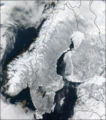File:Scandinavia NASA.jpg: Difference between revisions
Jump to navigation
Jump to search
imported>Caesar Schinas m (Replace Template:Information with Template:Image_Details) |
(== Summary == Importing file) Tag: Server-side upload |
||
| Line 1: | Line 1: | ||
== Summary == | == Summary == | ||
Importing file | |||
Latest revision as of 19:55, 11 March 2022
Summary
Importing file
File history
Click on a date/time to view the file as it appeared at that time.
| Date/Time | Thumbnail | Dimensions | User | Comment | |
|---|---|---|---|---|---|
| current | 19:55, 11 March 2022 |  | 540 × 611 (127 KB) | Maintenance script (talk | contribs) | == Summary == Importing file |
You cannot overwrite this file.
File usage
The following 2 files are duplicates of this file (more details):
- File:Scandinavian Peninsula in Winter (February 19, 2003).jpg from a shared repository
- File:Scandinavian Peninsula in Winter (February 19, 2003).jpg from Wikimedia Commons
The following page uses this file: